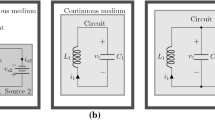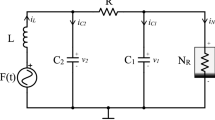Abstract
This is the second part of a two-part manuscript focused on the analysis of electronic circuits employing extended irreversible thermodynamics. In this contribution, internal entropy production is used as a Lyapunov function for a thermodynamically consistent model of Chua’s circuit to address stability properties of an isolated, isothermal system containing it. In order to achieve this, simpler electronic circuits are first analyzed with an increasing complexity in construction. Here an RC-nonlinear resistor circuit and an RLC-nonlinear resistor circuit are considered as a preamble of the study of Chua’s circuit. In this manner, the entropy production approach allows conservative and dissipative phenomena and their interactions to be identified and contrasted with those of simpler study cases. Identification of recurrent terms in the dynamics of the entropy production function leads to the description of elemental interactions among electronic components. Analytical results are supported with numerical simulations at specific conditions. Chaos and other complex behaviors, like limit cycles, are analyzed and described with entropic and energetic perspectives. Apart from the determination of their stability, entropic descriptions for nodes, saddles and foci observed in the study cases and their vicinities are presented. It is observed through an extended Gibbs free energy analysis that the dissipation in limit cycles equals the build-up of energy. On the contrary, the behavior of changes of the state variables in a strange attractor is energetically asynchronous and unbalanced.










Similar content being viewed by others
Availability of data and material
The data that support the findings of this study are available from authors upon reasonable request.
Code availability
The code that supports the findings of this study is available from authors upon reasonable request.
References
Lorenz, E.N.: Deterministic nonperiodic flow. J. Atmos. Sci. 20(2), 130–141 (1963)
Matsumoto, T.: A chaotic attractor from Chua’s circuit. IEEE Trans. Circuits Syst. 31(12), 1055–1058 (1984)
Chua, L.O., Komuro, M., Matsumoto, T.: The double scroll family. Parts I and II. IEEE Trans. Circuits Syst. 33(11), 1072–1118 (1986)
Chua, L.O.: A zoo of strange attractors from the canonical Chua’s circuits. In: Proceedings of the 35th Midwest Symposium on Circuits and Systems, 1992, pp. 916–926. IEEE (1992)
Chua, L.O., Wu, C.W., Huang, A., Zhong, G.Q.: A universal circuit for studying and generating chaos. I. Routes to chaos. IEEE Trans. Circuits Syst. I Fundam. Theory Appl. 40(10), 732–744 (1993)
Chua, L.O., Wu, C.W., Huang, A., Zhong, G.Q.: A universal circuit for studying and generating chaos II Strange attractors. IEEE Trans. Circuits Syst. I Fundam. Theory Appl. 40(10), 745–761 (1993)
Chua, L.O.: Chua’s circuit: ten years later. IEICE Trans. Fundam. Electron. Commun. Comput. Sci. 77(11), 1811–1822 (1994)
Dedieu, H., Kennedy, M.P., Hasler, M.: Chaos shift keying: modulation and demodulation of a chaotic carrier using self-synchronizing Chua’s circuits. IEEE Trans. Circuits Syst. II Analog Digit. Signal Process. 40(10), 634–642 (1993)
Peng, G., Min, F.: Multistability analysis, circuit implementations and application in image encryption of a novel memristive chaotic circuit. Nonlinear Dyn. 90(3), 1607–1625 (2017)
Swathy, P.S., Thamilmaran, K.: An experimental study on SC-CNN based canonical Chua’s circuit. Nonlinear Dyn. 71(3), 505–514 (2013)
Radwan, A.G., Soliman, A.M., El-Sedeek, A.L.: An inductorless CMOS realization of Chua’s circuit. Chaos Solitons Fractals 18(1), 149–158 (2003)
Kılıc, R., Çam, U., Alçı, M., Kuntman, H., Uzunhisarcıklı, E.: Realization of inductorless Chua’s circuit using FTFN-based nonlinear resistor and inductance simulator. Frequenz 58, 37–40 (2004)
Bao, B., Wang, N., Chen, M., Xu, Q., Wang, J.: Inductor-free simplified Chua’s circuit only using two-op-amp-based realization. Nonlinear Dyn. 84(2), 511–525 (2016)
Zhong, G.Q., Ayrom, F.: Experimental confirmation of chaos from Chua’s circuit. Int. J. Circuit Theory Appl. 13(1), 93–98 (1985)
Matsumoto, T., Chua, L., Komuro, M.: The double scroll. IEEE Trans. Circuits Syst. 32(8), 797–818 (1985)
Matsumoto, T., Chua, L.O., Tokumasu, K.: Double scroll via a two-transistor circuit. IEEE Trans. Circuits Syst. 33(8), 828–835 (1986)
Kennedy, M.P.: Robust op amp realization of Chua’s circuit. Frequenz 46(3–4), 66–80 (1992)
Senani, R., Gupta, S.S.: Implementation of Chua’s chaotic circuit using current feedback op-amps. Electron. Lett. 34(9), 829–830 (1998)
Elwakil, A.S., Kennedy, M.P.: Improved implementation of Chua’s chaotic oscillator using current feedback op amp. IEEE Trans. Circuits Syst. I Fundam. Theory Appl. 47(1), 76–79 (2000)
Cruz, J.M., Chua, L.O.: A CMOS IC nonlinear resistor for Chua’s circuit. IEEE Trans. Circuits Syst. I Fundam. Theory Appl. 39(12), 985–995 (1992)
Rodriguez-Vazquez, A., Delgado-Restituto, M.: CMOS design of chaotic oscillators using state variables: a monolithic Chua’s circuit. IEEE Trans. Circuits Syst. II: Analog Digit. Signal Process. 40(10), 596–613 (1993)
Zhong, G.Q.: Implementation of Chua’s circuit with a cubic nonlinearity. IEEE Trans. Circuits Syst. I Fundam. Theory Appl. 41(12), 934–941 (1994)
Eltawil, A.M., Elwakil, A.S.: Low-voltage chaotic oscillator with an approximate cubic nonlinearity. AEU-Int. J. Electron. C. 53(3), 11–17 (1999)
Srisuchinwong, B., San-Um, W.: A Chua’s chaotic oscillator based on a coarsely cubic-like CMOS resistor. In: Proc. Asia-Pacific Conf. Communications, pp. 47–49 (2007)
O’Donoghue, K., Kennedy, M.P., Forbes, P.: A fast and simple implementation of Chua’s oscillator using a ’cubic-like’ Chua diode. In: Proc. European Conf. Circuit Theory and Design, vol. 2, pp. II/83–II/86 (2005)
Munguía-Medina, S.J., García-Sandoval, J.P., González-Álvarez, A.: Stability analysis of a class of electronic circuits based on thermodynamic principles part I: analysis of limit cycles (submitted to Nonlinear Dynamics). Nonlinear Dyn. (2021)
Demirel, Y.: Nonequilibrium Thermodynamics: Transport and Rate Processes in Physical, Chemical and Biological Systems, 4th edn. Elsevier, New York (2018)
Dammers, W.R., Tels, M.: Thermodynamic stability and entropy production in adiabatic stirred flow reactors. Chem. Eng. Sci. 29(1), 83–90 (1974)
Landauer, R.: Stability and entropy production in electrical circuits. J. Stat. Phys. 13(1), 1–16 (1975)
Ydstie, B.E.: Passivity based control via the second law. Comput. Chem. Eng. 26(7–8), 1037–1048 (2002)
Jeltsema, D., Scherpen, J.M.A.: A power-based description of standard mechanical systems. Syst. Control Lett. 56(5), 349–356 (2007)
Favache, A., Dochain, D.: Thermodynamics and chemical systems stability: the CSTR case study revisited. J. Process Control 19(3), 371–379 (2009)
Jeltsema, D., Scherpen, J.M.A.: Multidomain modeling of nonlinear networks and systems. IEEE Control. Syst. 29(4) (2009)
Robinett, R.D., Wilson, D.G.: Exergy and irreversible entropy production thermodynamic concepts for nonlinear control design. Int. J. Exergy 6(3), 357–387 (2009)
García-Canseco, E., Jeltsema, D., Ortega, R., Scherpen, J.M.A.: Power-based control of physical systems. Automatica 46(1), 127–132 (2010)
García-Sandoval, J.P., González-Álvarez, V., Calderón, C.: Stability analysis and passivity properties for a class of chemical reactors: internal entropy production approach. Comput. Chem. Eng. 75, 184–195 (2015)
García-Sandoval, J.P., Dochain, D., Hudon, N.: Dissipative and conservative structures for thermo-mechanical systems. IFAC-PapersOnLine 48(8), 1057–1064 (2015)
García-Sandoval, J.P., Hudon, N., Dochain, D., González-Álvarez, V.: Stability analysis and passivity properties of a class of thermodynamic processes: an internal entropy production approach. Chem. Eng. Sci. 139, 261–272 (2016)
Alonso, A.A., Ydstie, B.E.: Stabilization of distributed systems using irreversible thermodynamics. Automatica 37(11), 1739–1755 (2001)
Favache, A., Dochain, D., Maschke, B.: An entropy-based formulation of irreversible processes based on contact structures. Chem. Eng. Sci. 65(18), 5204–5216 (2010)
van der Schaft, A.J.: Port-controlled Hamiltonian systems: towards a theory for control and design of nonlinear physical systems. J. Soc. Instrum. Control Eng. 39(2), 91–98 (2000)
van der Schaft, A., Jeltsema, D.: Port-Hamiltonian Systems Theory: An Introductory Overview. Foundations and Trends in Systems and Control. Now Publishers (2014)
García-Sandoval, J.P., Hudon, N., Dochain, D.: Generalized Hamiltonian representation of thermo-mechanical systems based on an entropic formulation. J. Process Control 51, 18–26 (2017)
Yu, H., Yu, J., Wu, H., Li, H.: Energy-shaping and integral control of the three-tank liquid level system. Nonlinear Dyn. 73(4), 2149–2156 (2013)
Kang, J., Zhu, Z.H.: A unified energy-based control framework for tethered spacecraft deployment. Nonlinear Dyn. 95(2), 1117–1131 (2019)
García-Sandoval, J.P., Hudon, N., Dochain, D.: Conservative and dissipative phenomena in thermodynamical systems stability. IFAC-PapersOnLine 49(24), 28–33 (2016)
Chua, L.O., Huynh, L.T.: Bifurcation analysis of Chua’s circuit. In: Proceedings of the 35th Midwest Symposium on Circuits and Systems, pp. 746–751. IEEE (1992)
Komuro, M., Tokunaga, R., Matsumoto, T., Chua, L.O., Hotta, A.: Global bifurcation analysis of the double scroll circuit. Int. J. Bifurc. Chaos 1(01), 139–182 (1991)
Parlitz, U.: Lyapunov exponents from Chua’s circuit. J. Circuits Syst. Comput. 3(02), 507–523 (1993)
Sira-Ramirez, H., Cruz-Hernández, C.: Synchronization of chaotic systems: a generalized Hamiltonian systems approach. Int. J. Bifur. Chaos 11(05), 1381–1395 (2001)
Bar-Yam, Y.: Dynamics of Complex Systems. Addison-Wesley, Boston (1997)
Chen, L., Zhou, Y., Yang, F., Zhong, S., Zhang, J.: Complex dynamical behavior in memristor-capacitor systems. Nonlinear Dyn. 98(1), 517–537 (2019)
Ramirez, H., Le Gorrec, Y., Maschke, B., Couenne, F.: Passivity based control of irreversible port Hamiltonian systems. IFAC Proc. Vol. 46(14), 84–89 (2013)
Acknowledgements
Sergio Javier Munguía-Medina thanks Consejo Nacional de Ciencia y Tecnología (CONACyT) for the financial support under Grant Agreement No. 706022.
Author information
Authors and Affiliations
Contributions
Sergio Javier Munguía-Medina involved in formal analysis, investigation, resources, software, visualization, writing—original draft. Juan Paulo García-Sandoval involved in conceptualization, formal analysis, methodology, project administration, resources, supervision, validation, writing—review & editing. Alejandro González-Álvarez involved in resources, supervision, writing—review & editing.
Corresponding author
Ethics declarations
Conflict of interest
The authors declare that they have no conflict of interest.
Additional information
Publisher's Note
Springer Nature remains neutral with regard to jurisdictional claims in published maps and institutional affiliations.
Supplementary Information
Below is the link to the electronic supplementary material.
Rights and permissions
About this article
Cite this article
Munguía-Medina, S.J., García-Sandoval, J.P. & González-Álvarez, A. Stability analysis of a class of electronic circuits based on thermodynamic principles part II: analysis of chaos in Chua’s circuit. Nonlinear Dyn 105, 3637–3658 (2021). https://doi.org/10.1007/s11071-021-06753-0
Received:
Accepted:
Published:
Issue Date:
DOI: https://doi.org/10.1007/s11071-021-06753-0




